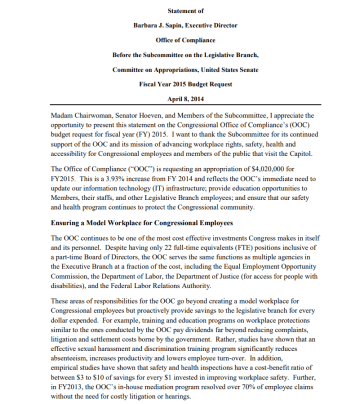Statement of Barbara J. Sapin, Executive Director Office of Compliance Before the Subcommittee on the Legislative Branch, Committee on Appropriations, United States Senate Fiscal Year 2015 Budget Request April 8, 2014
Madam Chairwoman, Senator Hoeven, and Members of the Subcommittee, I appreciate the opportunity to present this statement on the Congressional Office of Compliance’s (OOC) budget request for fiscal year (FY) 2015. I want to thank the Subcommittee for its continued support of the OOC and its mission of advancing workplace rights, safety, health and accessibility for Congressional employees and members of the public that visit the Capitol. The Office of Compliance (“OOC”) is requesting an appropriation of $4,020,000 for FY2015. This is a 3.93% increase from FY 2014 and reflects the OOC’s immediate need to update our information technology (IT) infrastructure; provide education opportunities to Members, their staffs, and other Legislative Branch employees; and ensure that our safety and health program continues to protect the Congressional community.
Ensuring a Model Workplace for Congressional Employees
The OOC continues to be one of the most cost effective investments Congress makes in itself and its personnel. Despite having only 22 full-time equivalents (FTE) positions inclusive of a part-time Board of Directors, the OOC serves the same functions as multiple agencies in the Executive Branch at a fraction of the cost, including the Equal Employment Opportunity Commission, the Department of Labor, the Department of Justice (for access for people with disabilities), and the Federal Labor Relations Authority. These areas of responsibilities for the OOC go beyond creating a model workplace for Congressional employees but proactively provide savings to the legislative branch for every dollar expended. For example, training and education programs on workplace protections similar to the ones conducted by the OOC pay dividends far beyond reducing complaints, litigation and settlement costs borne by the government. Rather, studies have shown that an effective sexual harassment and discrimination training program significantly reduces absenteeism, increases productivity and lowers employee turn-over. In addition, empirical studies have shown that safety and health inspections have a cost-benefit ratio of between $3 to $10 of savings for every $1 invested in improving workplace safety. Further, in FY2013, the OOC’s in-house mediation program resolved over 70% of employee claims without the need for costly litigation or hearings.

